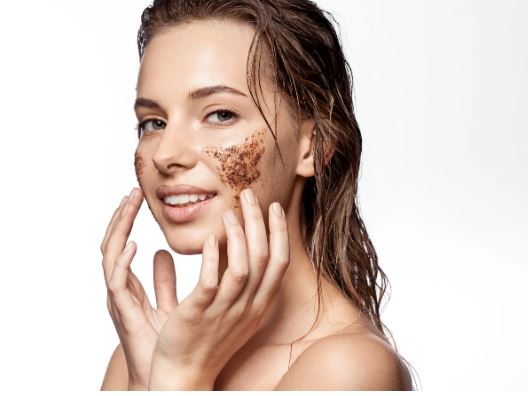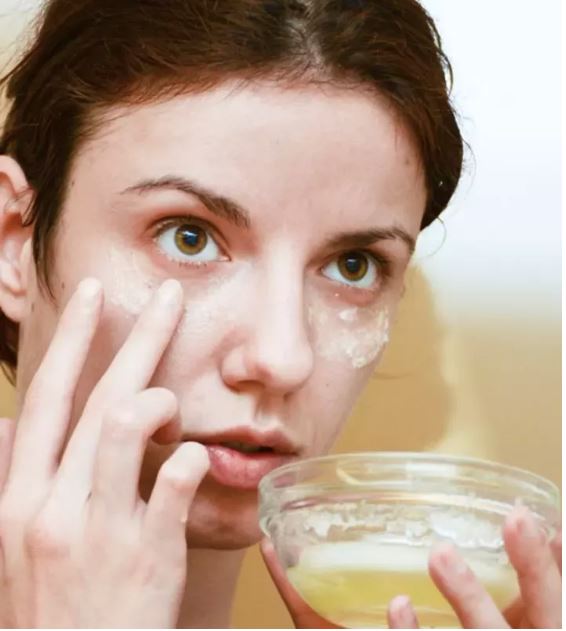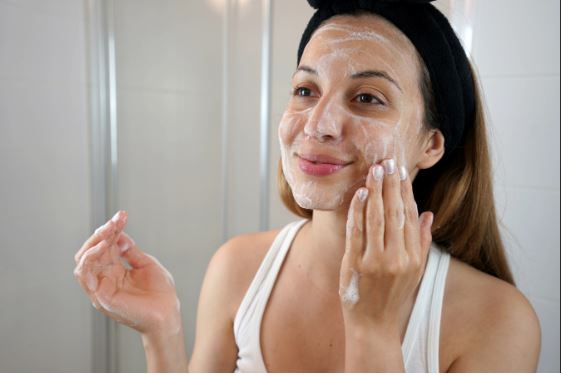10 Essential Skincare Tips for Oily Skin
Oily skin can be a bit of a challenge, but with the right tips and tricks, you can keep it looking fresh and radiant. Here are 15 gentle skincare tips tailored specifically for oily skin, designed to help balance and nourish without overwhelming your complexion.
Spot Treatments for Breakouts
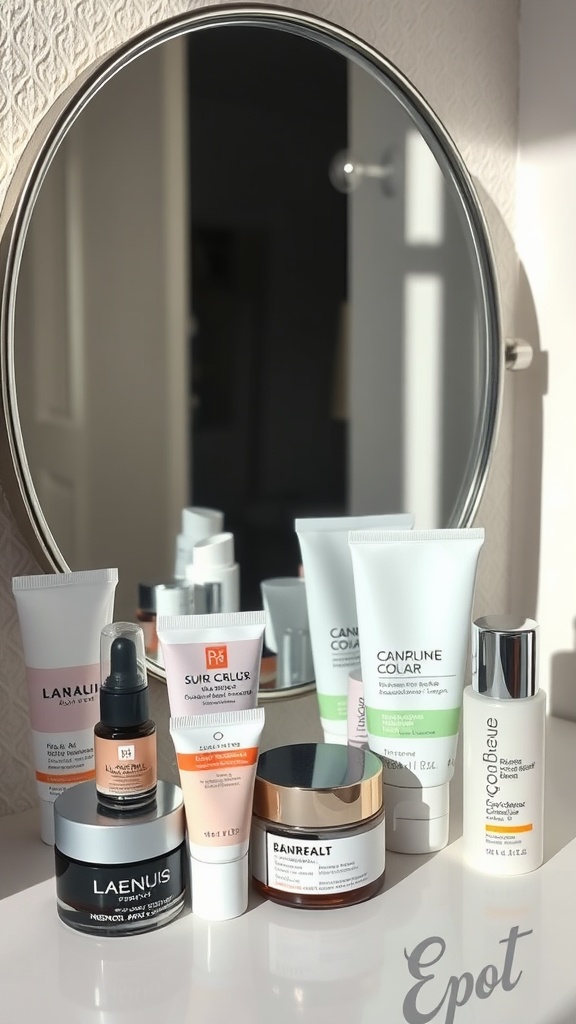
Breakouts can be frustrating, especially if you have oily skin. A good spot treatment can be a lifesaver when a pesky pimple pops up. The right products can help reduce inflammation and speed up healing. In the image, you’ll see a selection of skincare products that may include spot treatments among other helpful items.
Look for ingredients like salicylic acid, benzoyl peroxide, or tea tree oil. These are known for their acne-fighting properties. Apply a small amount directly to the blemish and let it work its magic. Remember to follow up with your regular skincare routine.
Understanding Oily Skin Types
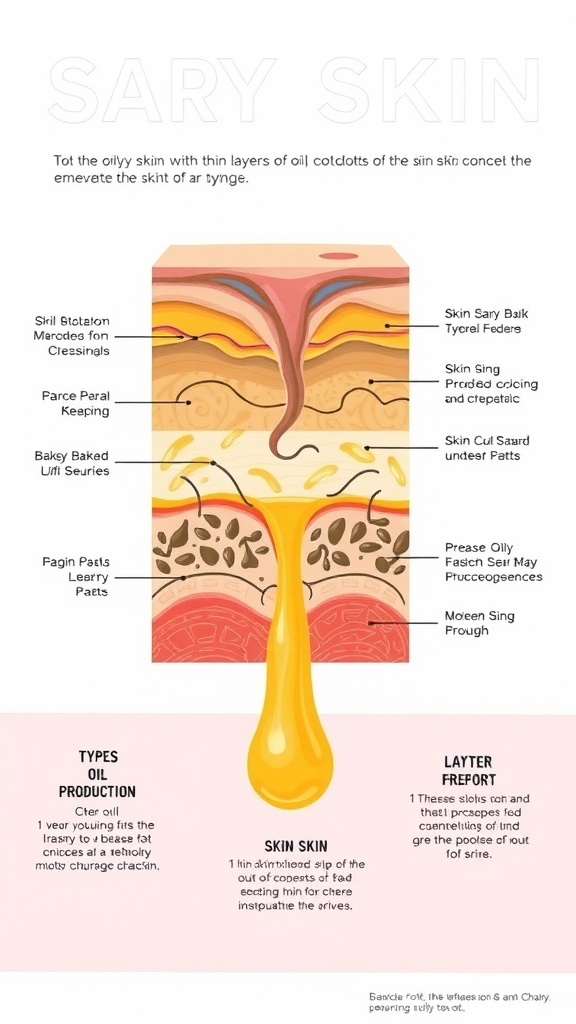
Oily skin can often feel like a mystery. It tends to produce more oil than other skin types, leading to a shiny appearance and sometimes breakouts. The image shows a cross-section of oily skin, highlighting how oil is produced and the structure of the skin itself.
In this diagram, we can see layers where oil glands are present. These glands produce sebum, which is a natural oil that keeps our skin moisturized. For those with oily skin, these glands can be overactive, leading to excessive shine and clogged pores.
Understanding how your skin works is the first step toward caring for it properly. The image breaks down the skin layers and the process of oil production. This can help demystify why some people experience more oil than others. Knowing this can guide you in choosing the right skincare products.
Whether you’re dealing with a shiny T-zone or frequent breakouts, recognizing your skin type can help you tackle any issues with confidence. Oily skin needs gentle care to maintain balance while keeping it clean and hydrated.
Utilizing Clay Masks for Oil Control
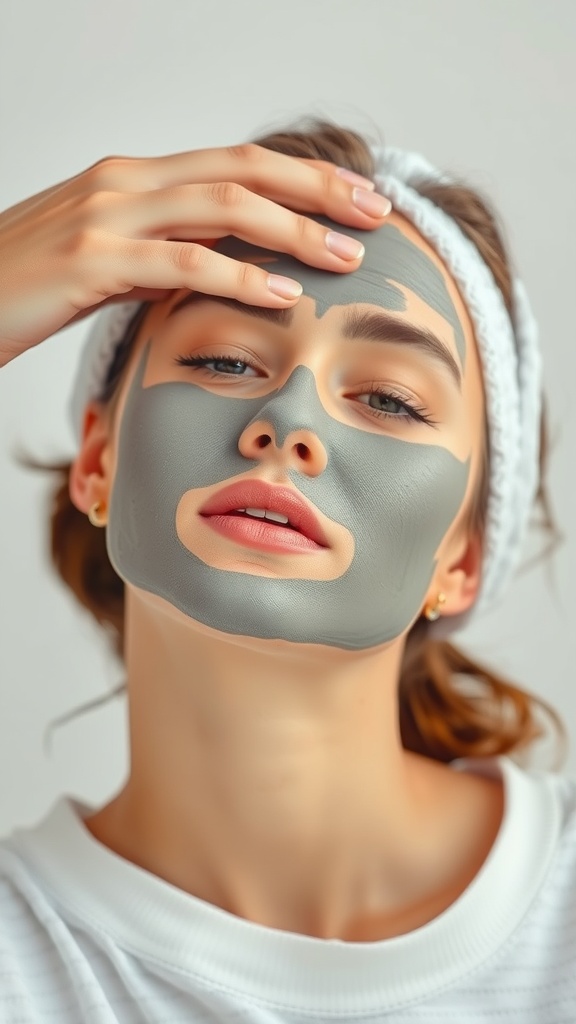
Clay masks are a fantastic option for managing oily skin. They help absorb excess oil and draw out impurities, leaving your skin feeling fresh and clean. The image shows a woman with a clay mask on her face, giving us a glimpse of how relaxing and effective this skincare routine can be.
In the picture, she seems focused and calm, which is a great reminder that skincare is not just about the product but also about taking time for yourself. You can choose from various types of clay, like bentonite or kaolin, depending on your skin’s needs.
To use a clay mask, start by cleansing your face. Apply a thin layer of the mask evenly, avoiding the eye area. Let it sit for about 10-15 minutes until it dries. Rinse it off with warm water, and voilà! You’ll notice a significant reduction in shine.
Incorporating clay masks into your weekly routine can balance your skin’s oil production. Remember to follow up with a moisturizer, as even oily skin needs hydration. This simple step can keep your skin healthy and glowing!
Exfoliation Techniques for Oily Skin
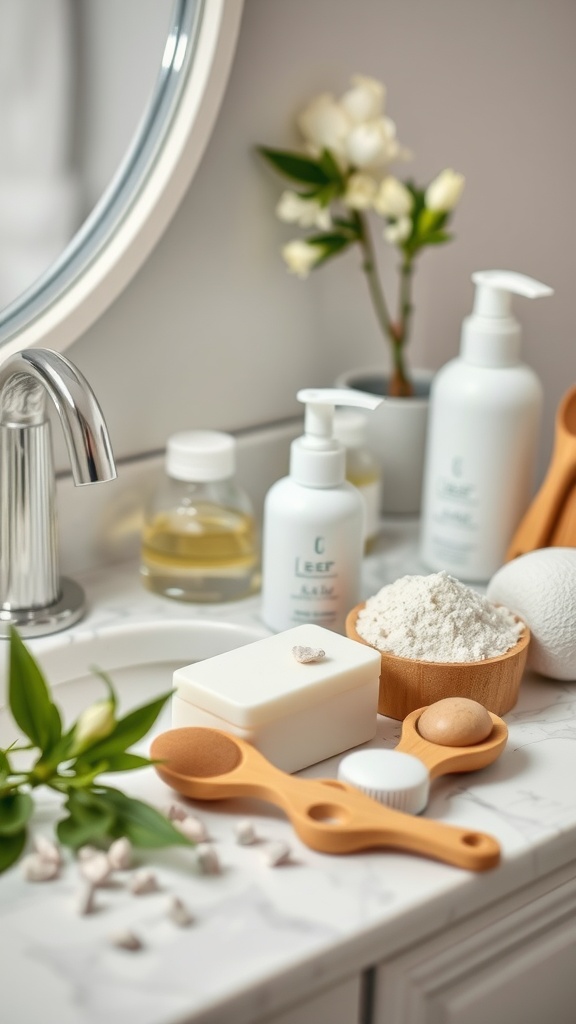
Exfoliation is key for managing oily skin. It helps remove dead skin cells and excess oil, preventing clogged pores. The image shows a serene bathroom setup, highlighting skincare products and tools that are perfect for this purpose. A lovely touch of greenery adds a fresh vibe, making the space inviting.
You can use physical exfoliants like scrubs with gentle microbeads or natural ingredients that won’t irritate your skin. Look for exfoliating products that include salicylic acid. This ingredient works wonders by penetrating deep into pores and reducing excess oil.
Another great option is chemical exfoliation. Products with AHAs and BHAs can provide a gentle way to remove dead skin without harsh scrubbing. Always follow up with a good moisturizer to keep your skin hydrated. Remember to exfoliate 1-2 times a week to keep your skin balanced and glowing!
Choosing the Right Cleanser

When it comes to caring for oily skin, choosing the right cleanser is key. The image shows a selection of cleansers that cater to this specific skin type. Each bottle is labeled and designed to address excess oil, which can lead to breakouts if not managed properly.
First, look for gel-based or foaming cleansers. These formulas help to deeply cleanse pores and remove excess shine. The bottles in the image, especially those labeled ‘Clandine Cleansers,’ suggest a focus on gentle yet effective cleansing.
Avoid creamy or oil-based cleansers, as they can add unwanted moisture to oily skin. Instead, opt for ingredients like salicylic acid or tea tree oil, which are known for their oil-controlling properties. The variety displayed in the image hints at the importance of finding a cleanser that feels right for your skin.
Lastly, remember to test a small amount first. Everyone’s skin reacts differently, so it’s smart to see how your skin responds before fully committing. Happy cleansing!
The Role of Sunscreen in Oily Skin Care

Oily skin often comes with its own set of challenges, but don’t forget that sunscreen is a must, no matter your skin type. The image shows a person applying sunscreen, highlighting its importance in a daily skincare routine.
Sunscreen helps protect your skin from harmful UV rays, which can lead to premature aging and skin damage. Even if you have oily skin, skipping sunscreen can cause long-term issues. It’s essential to choose a lightweight, non-comedogenic formula. This means it won’t clog your pores, making it suitable for those who struggle with excess oil.
Many sunscreens today are designed for oily skin. They often come in gel or matte finishes, helping to control shine throughout the day. Applying sunscreen daily can keep your skin healthy and glowing without adding extra oil.
Incorporating Oil-Free Moisturizers
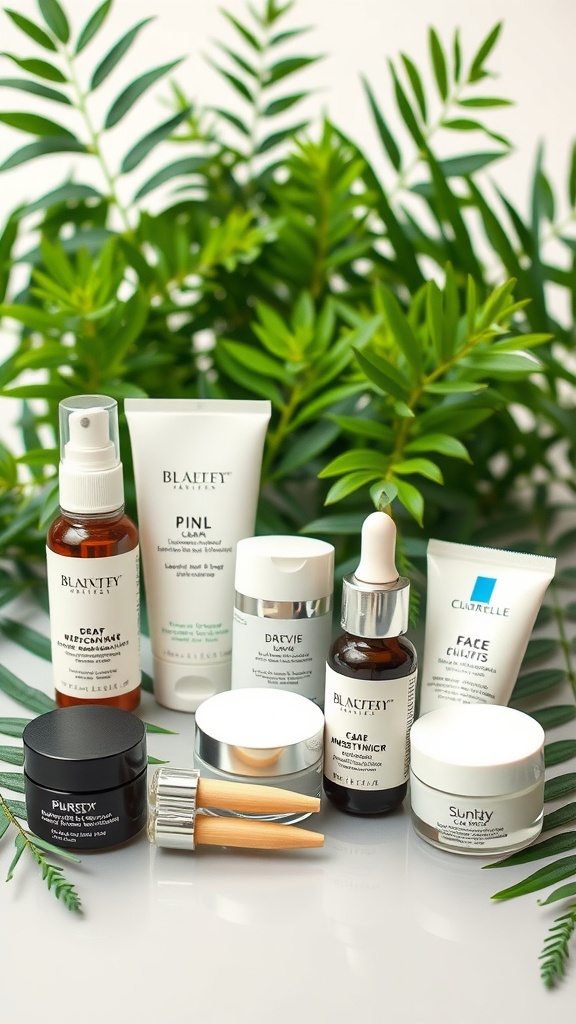
When it comes to oily skin, finding the right moisturizer can feel tricky. The image shows a collection of oil-free products that are perfect for keeping your skin hydrated without adding extra shine.
Each moisturizer in the image is designed to provide hydration while controlling excess oil. Look for lightweight formulas that absorb quickly and don’t clog pores. Ingredients like hyaluronic acid, glycerin, and aloe vera are fantastic choices.
Using an oil-free moisturizer daily helps maintain the skin’s balance. It keeps your skin from overproducing oil while providing the moisture it needs. Remember, even oily skin needs hydration!
Try applying your moisturizer after cleansing to lock in moisture. This simple step can make a significant difference in how your skin feels and looks. So, grab a product that suits your skin type and enjoy a fresh, matte finish!
Importance of Hydration
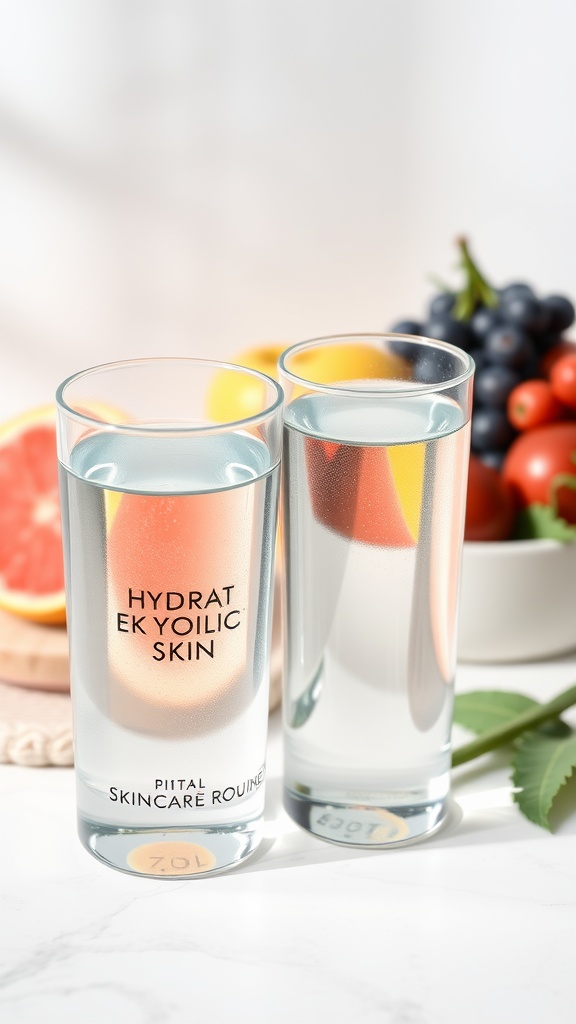
Hydration plays a key role in managing oily skin. You may think that oily skin doesn’t need extra moisture, but that’s a common misconception. The image above shows two glasses of water, symbolizing how vital adequate hydration is for your skin’s health.
When your skin is properly hydrated, it can help balance oil production. If your skin feels dry, it might compensate by producing more oil, leading to breakouts. So, drinking enough water is essential. Aim for at least eight glasses a day, and don’t forget that fruits and vegetables can contribute to your hydration.
Incorporating hydrating ingredients into your skincare routine also helps. Look for products that contain hyaluronic acid or glycerin. These ingredients attract moisture to your skin, giving it a plump and fresh look.
In essence, staying hydrated supports not just your skin but your overall well-being too. So, keep that water bottle close and drink up!
Dietary Adjustments for Balanced Skin

When it comes to oily skin, diet plays a big role in how your skin looks and feels. The image shows a vibrant array of fresh vegetables and fruits, all packed with nutrients that can help balance skin oils.
Incorporating leafy greens like spinach and crunchy carrots into your meals can be a game-changer. These veggies are rich in vitamins and antioxidants. They help your skin stay clear and hydrated. Tomatoes are also great; they contain lycopene, which can reduce redness and protect your skin.
Don’t overlook fruits like strawberries and blackberries, which are loaded with antioxidants. Antioxidants fight free radicals, keeping your skin youthful and glowing. Pairing these with healthy fats, like avocados, can help keep your skin moisturized without adding excess oil.
Staying hydrated is key too! Water helps flush out toxins and keeps your skin looking fresh. So, fill your plate with color and enjoy these healthy foods. Your skin will thank you!
Nighttime Skincare Rituals
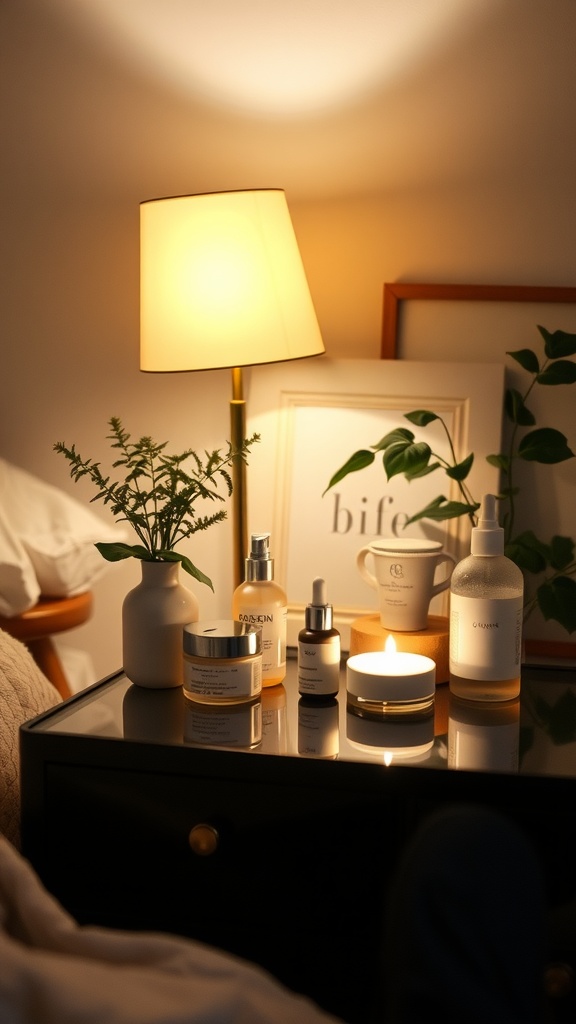
A calming nighttime skincare routine can make a big difference for oily skin. The image shows a cozy bedside table adorned with a variety of skincare products, a soft glow from a lamp, and a flickering candle. This setup not only looks inviting but also sets the mood for relaxation.
Start your nighttime ritual by creating a peaceful environment. The warm light and soothing scents help signal to your skin that it’s time to unwind. Begin by cleansing your face to remove impurities and excess oil. Choose a gentle cleanser that won’t strip your skin of its natural moisture.
Next, layer on a lightweight serum that targets oiliness and helps to balance your skin. Look for ingredients like hyaluronic acid or niacinamide. These can hydrate without adding extra oil. Following the serum, apply a non-comedogenic moisturizer that keeps your skin hydrated while preventing breakouts.
Lastly, don’t forget the eye cream. This can help reduce puffiness and dark circles, giving you a fresh look in the morning. Take a moment to enjoy a calming activity, like reading or meditating, to truly relax before bed.
